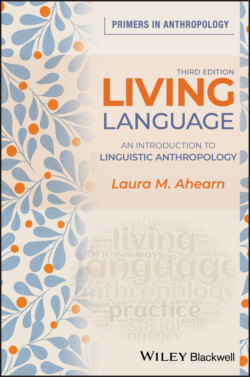Читать книгу Living Language - Laura M. Ahearn - Страница 44
Interviews
ОглавлениеLinguistic anthropologists, like many other social scientists, not to mention journalists, public opinion pollsters, market researchers, social workers, and others, often make use of interviews to gather information. The types of information requested vary widely, as does the format of the interview, which can be structured (with a list of questions asked of all research subjects in the same order), semi-structured (with a list of general areas the researcher would like to discuss, but no strict order or wording), or open-ended (informal conversations designed to elicit topics of importance to the research subjects themselves). Sometimes all of these types of interviews are used at some point during a research project.
Linguistic anthropologists may use interviews to gather general background information about cultural norms and social practices in their research communities, and/or they may conduct interviews to ask people’s opinions about various linguistic usages. Linguistic anthropologists might also seek out individuals to help them understand the meanings of particularly important and complex words and concepts. Those scholars working on endangered languages that have never before been studied or perhaps even written down must work closely with speakers of these languages to document as much of the grammar, vocabulary, verbal art, and social contexts of language use as possible before the languages become extinct.5
No matter what the content or format of the interviews conducted, however, most linguistic anthropologists do not treat interviews as transparent – as linguistic data they can reach “through” to get to the “facts.” Instead, they recognize the importance of analyzing the interview context itself. Linguistic anthropologists strongly maintain that meanings emerge in specific social interactions, and interviews are no exception. As Charles Briggs (1986, 2007) has repeatedly reminded us, the interviewer is a co-participant in the interaction, and this can have an enormous effect on what is said, how it is said, and why it is said. For a scholar to gloss over or omit this aspect of the interview entirely when writing about it is, at best, to miss an opportunity to enrich the analysis and, at worst, to fail to understand the significance of what the interviewee was (or was not) saying.
Thinking back to Jakobson’s model of the multiple functions of language, the “referential” function – that which communicates information about the world – is just one of six functions of language. Interviews should not, therefore, be reduced to this function alone. In addition, since meanings are conveyed through multiple modalities, as we discussed in the previous chapter, the interviewer should videotape or at least audiotape the interaction whenever it is logistically and ethically feasible to do so. This will facilitate a more nuanced analysis during the write-up phase of the research.
It is extremely important to remember, however, that in many societies, the interview is not the preferred way of communicating information – if it is a speech genre familiar to the interviewees at all. A researcher who attempts to use interviews in such a society will either obtain mistaken information or no information at all. For this reason, Briggs (1986:93) strongly encourages researchers in all fields (not just linguistic anthropology) to “learn how to ask” in culturally appropriate ways by paying close attention to how people in the community use language in all sorts of situations. Briggs (2007) also urges us all to become more aware of how the ideas people express in interviews circulate in many different venues – in scholarly articles and books, informal conversations, and the mass media, for example.
In sum, as important as the interview is as a research method, it is often mistakenly assumed to provide a simple, straightforward path toward “the facts” or “the truth.” Interviews can indeed provide rich insights, but they must be appreciated as the complex, culturally mediated social interactions that they are.
